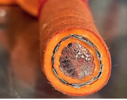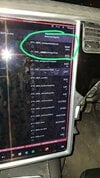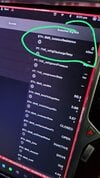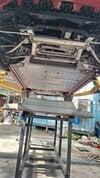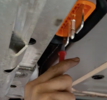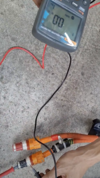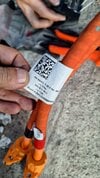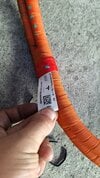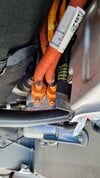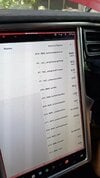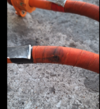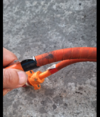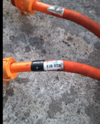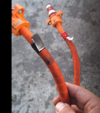Hi all,
I am newbies here, would like to share a nightmare isolation fault story on my friend's Tesla Model S, he purchased as second hand and have been running good over last year for over 20k km..
It's the first time I mess with the electric car, while I have been DIYing petrol car for over 10 years. Thanks for this forum providing huge amount of valuable information on electric vechicle.
The story started with 2 months ago, my friend called me that his tesla is NO START symptom, it was isolation faults, then he towed to service center. what the service center said there are some error code stored in AC module and Battery Heater module.
Interestingly the service center is unable to confirm it is the root cause, and asking for additional $750 for in-depth checking by removal of battery.
Then this car is towed to my DIY playground, and then I eventually encountered the term: ISOLATION, as it will never exist in 12V petrol car world.

I purchased a fluke isolation meter and perform all the testing for
- PTC heater (+ve -ve are in good isolation)
- battery heater (+ve -ve are in good isolation)
- DC-DC Invertor (+ve -ve are in good isolation)
- AC pump (+ve -ve sometimes good, but one time bad, only got 6Mohm for both HV cable with 250V testing voltage)
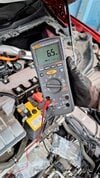
Then I was stucked at that moment, and then we attempted to recall what the service center say, we purchased a brand new AC PUMP and Battery Heater to give a shot.
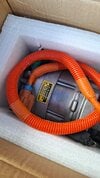
Unfortunately the replacement is done, and the car is still NO start, same ISOATION faults occurs.
Then I purchase 1 day access of toolbox 3 to see what is going on actually.
Some interesting finding is, I entered service mode via toolbox 3, and then select some data stream to monitor
most of the time the information is as below (which indicate the battery is healthy)
- BMS_state FAULT
- BMS_isolationResistance 3500kOhm
- BMS_contactorState OPEN

while the car will peroidically attempt to close the contactor (the isolationResistance drops to 0 kOhm during PreCharging state!)
- BMS_isolationResistance 0kOhm
- BMS_state PRECHARGING
- BMS_contactorState OPEN
So, it defintely got some isolation fault, as the number should not be lower than 10k Ohm, and now it's 0k Ohm.
As the car is pushed to a location which is far away from the jack, it would be quickest to check from the Charging Module located at the back seat.
Taking off the seat and test the isolation, Vola!
+ve 0Mohm, -ve 0Mohm
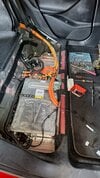
So happy that at least confirmed there must be some short circuit to ground along the HV path, now then I detach the HV cables connected to the Charging module and retest the charging module isoation, got around +ve 25Mohm and -ve 25Mohm
and then testing the cable, it was 0Mohm for both +ve and -ve...
which indicates there must be some other parts which causing the error, and then I have no choice, but to roll the car up the jack and perform the rear motor isolation test
luckily rear motor seems OK.
I have detached the cable from rear motor and both HV cables still got 0Mohm reading. which leads me to test the front of the car.
I take off the left wheel and the trim, then able to access to the front motor connector, I detached it, and test again
The result is interesting
+ve is having 1.2MOhm reading
-ve is having 0MOhm reading
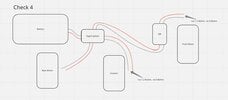
I replug the HV cable to the front motor, I got
+ve 0MOhm
-ve 0MOhm
again...
There must be some faults between battery, rapid splitter, FJB...
I scheduled a day to do the job, so need to prepare a stand for temporary holding the battery, and then do the troubleshooting.
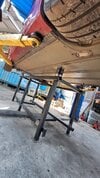
Once I got the battery removed, I started to test at the rear motor HV cable
got the same reading
+ve 1.2Mohm
-ve 0Mohm
which is good news, as this isolation is NOT related to battery
Then I detach the connector on FJB which links to rapid splitter, then perform test on the HV cables
+ve 550Mohm
-ve 550Mohm
wow, which can conclude that there must be something wrong with FJB!!!
but wait, I then try to disconnect the HV cable linked between FJB -> Front motor, and do some isolation testing on FJB
+ve 550Mohm
-ve 550Mohm
hmm, not the FJB module, then it must be the HV cable between FJB -> Front motor, and I tested,
+ve 550Mohm
-ve 550Mohm
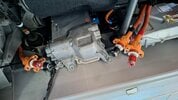
It's a nightmare, and I am stucked at this point.
Suddenly, I remember during the detach of the negative HV cable on between FJB -> Front motor, this cable is tightly touching the 12V +ve cable,
There is a scratch mark on this 12V +ve cable, and this 12V +ve cable is also touching the ground wire, although the ground wire is covered with insulation.
What my thinking is, the HV cable is connected to the front motor, which is secured by motor mount. which means there might be some minor up and down movement for the cable or pressures applied to the cable, that in the long run, it will eventually make the insulation weaker and weaker, that allow the high voltage to pass through.
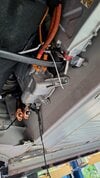
I covered the affected area with insulation tape, and then seperated the 12V +ve and HV -ve by rubber and then reattach the HV cables to FJB, retest the isolation
+ve 550Mohm
-ve 550Mohm
what the hack, it's magical!!!
then assemble all the connections and attach the battery, retest at the HV cable in rear motor, I got
+ve 25MOhm
-ve 25MOhm
which is excellent.
after connecting all those connector back, and the car is able to MOVE!
the entire journey makes me think that, it's kind of a design flaw, the concept of isolation is easy to get, but to actually do the real isolation testing, it is not a small job...
I hope my experience would help someone when they are struggling, and sorry for the long post.
I am newbies here, would like to share a nightmare isolation fault story on my friend's Tesla Model S, he purchased as second hand and have been running good over last year for over 20k km..
It's the first time I mess with the electric car, while I have been DIYing petrol car for over 10 years. Thanks for this forum providing huge amount of valuable information on electric vechicle.
The story started with 2 months ago, my friend called me that his tesla is NO START symptom, it was isolation faults, then he towed to service center. what the service center said there are some error code stored in AC module and Battery Heater module.
Interestingly the service center is unable to confirm it is the root cause, and asking for additional $750 for in-depth checking by removal of battery.
Then this car is towed to my DIY playground, and then I eventually encountered the term: ISOLATION, as it will never exist in 12V petrol car world.

I purchased a fluke isolation meter and perform all the testing for
- PTC heater (+ve -ve are in good isolation)
- battery heater (+ve -ve are in good isolation)
- DC-DC Invertor (+ve -ve are in good isolation)
- AC pump (+ve -ve sometimes good, but one time bad, only got 6Mohm for both HV cable with 250V testing voltage)

Then I was stucked at that moment, and then we attempted to recall what the service center say, we purchased a brand new AC PUMP and Battery Heater to give a shot.

Unfortunately the replacement is done, and the car is still NO start, same ISOATION faults occurs.
Then I purchase 1 day access of toolbox 3 to see what is going on actually.
Some interesting finding is, I entered service mode via toolbox 3, and then select some data stream to monitor
most of the time the information is as below (which indicate the battery is healthy)
- BMS_state FAULT
- BMS_isolationResistance 3500kOhm
- BMS_contactorState OPEN

while the car will peroidically attempt to close the contactor (the isolationResistance drops to 0 kOhm during PreCharging state!)
- BMS_isolationResistance 0kOhm
- BMS_state PRECHARGING
- BMS_contactorState OPEN
So, it defintely got some isolation fault, as the number should not be lower than 10k Ohm, and now it's 0k Ohm.
As the car is pushed to a location which is far away from the jack, it would be quickest to check from the Charging Module located at the back seat.
Taking off the seat and test the isolation, Vola!
+ve 0Mohm, -ve 0Mohm

So happy that at least confirmed there must be some short circuit to ground along the HV path, now then I detach the HV cables connected to the Charging module and retest the charging module isoation, got around +ve 25Mohm and -ve 25Mohm
and then testing the cable, it was 0Mohm for both +ve and -ve...
which indicates there must be some other parts which causing the error, and then I have no choice, but to roll the car up the jack and perform the rear motor isolation test
luckily rear motor seems OK.
I have detached the cable from rear motor and both HV cables still got 0Mohm reading. which leads me to test the front of the car.
I take off the left wheel and the trim, then able to access to the front motor connector, I detached it, and test again
The result is interesting
+ve is having 1.2MOhm reading
-ve is having 0MOhm reading

I replug the HV cable to the front motor, I got
+ve 0MOhm
-ve 0MOhm
again...
There must be some faults between battery, rapid splitter, FJB...
I scheduled a day to do the job, so need to prepare a stand for temporary holding the battery, and then do the troubleshooting.

Once I got the battery removed, I started to test at the rear motor HV cable
got the same reading
+ve 1.2Mohm
-ve 0Mohm
which is good news, as this isolation is NOT related to battery
Then I detach the connector on FJB which links to rapid splitter, then perform test on the HV cables
+ve 550Mohm
-ve 550Mohm
wow, which can conclude that there must be something wrong with FJB!!!
but wait, I then try to disconnect the HV cable linked between FJB -> Front motor, and do some isolation testing on FJB
+ve 550Mohm
-ve 550Mohm
hmm, not the FJB module, then it must be the HV cable between FJB -> Front motor, and I tested,
+ve 550Mohm
-ve 550Mohm

It's a nightmare, and I am stucked at this point.
Suddenly, I remember during the detach of the negative HV cable on between FJB -> Front motor, this cable is tightly touching the 12V +ve cable,
There is a scratch mark on this 12V +ve cable, and this 12V +ve cable is also touching the ground wire, although the ground wire is covered with insulation.
What my thinking is, the HV cable is connected to the front motor, which is secured by motor mount. which means there might be some minor up and down movement for the cable or pressures applied to the cable, that in the long run, it will eventually make the insulation weaker and weaker, that allow the high voltage to pass through.

I covered the affected area with insulation tape, and then seperated the 12V +ve and HV -ve by rubber and then reattach the HV cables to FJB, retest the isolation
+ve 550Mohm
-ve 550Mohm
what the hack, it's magical!!!
then assemble all the connections and attach the battery, retest at the HV cable in rear motor, I got
+ve 25MOhm
-ve 25MOhm
which is excellent.
after connecting all those connector back, and the car is able to MOVE!
the entire journey makes me think that, it's kind of a design flaw, the concept of isolation is easy to get, but to actually do the real isolation testing, it is not a small job...
I hope my experience would help someone when they are struggling, and sorry for the long post.



